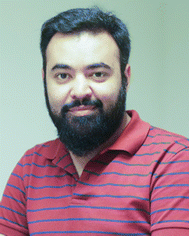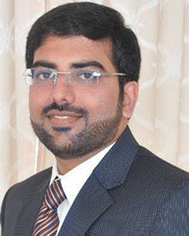Materials Horizons Emerging Investigator Series: Dr Muhammad Zubair and Dr Muhammad Qasim Mehmood, Information Technology University of the Punjab, Pakistan
Abstract
Our Emerging Investigator Series features exceptional work by early-career researchers working in the field of materials science.
Dr Muhammad Zubair received his PhD (2015) in electronics and communication engineering from the Politecnico di Torino, Italy. He was a postdoctoral research fellow (2015–2017) with the SUTD-MIT International Design Centre, Singapore. In 2017, He joined the Information Technology University, Lahore, as an assistant professor in electrical engineering, where he is currently an associate professor. He was an affiliate researcher (2024) with the James Watt School of Engineering, University of Glasgow, UK, a visiting faculty/research scientist at King Abdullah University of Science and Technology (2022–2024), and visiting faculty (Summer 2017 and 2018) at the Singapore University of Technology and Design, Singapore. His broad research interests are in fractional modelling, applied electromagnetics, and photonics, with a focus on developing models, materials, and devices enabling innovative electronic and photonic technologies. He has played a key role as a principal investigator or contributing researcher in projects funded by the Qatar National Research Foundation, the Higher Education Commission of Pakistan, the Punjab Higher Education Commission, the Ministry of Education, Singapore, Temasek Lab, and the Air Force Office of Scientific Research. He has published over 180 peer-reviewed journal and conference publications and two monograph/book chapters. Stanford–Elsevier has listed him among the top 2% of most-cited scholars worldwide since 2022. His recent awards include the International Union of Radio Science (URSI) Young Scientist Award, IEEE Outstanding Chapter Award, and Punjab Innovation Research Challenge Award. In addition, he has received recognition for several high-impact publications, including Nanoscale Horizons Most Popular Article 2023 and Nanoscale Most Popular Article 2022, as well as IET Microwaves, Antennas & Propagation Top Downloaded Paper 2024. He is a senior member of IEEE, and a member of IET, ACES, OPTICA, and SPIE. He has served as an associate editor on prestigious journals like IET Microwaves, Antennas & Propagation, IEEE Access, PLOS One, and the International Journal of Antennas and Propagation.
Dr Muhammad Qasim Mehmood received his PhD in electrical and computer engineering from the National University of Singapore, Singapore, in 2016. Currently, he works as an associate professor in the Department of Electrical Engineering at Information Technology at the University of Punjab (ITU), Lahore, Pakistan. His research interests include metaoptics and metaphotonics, optical and photonics engineering, antenna and microwave engineering, and printed electronics. He has published over two hundred papers in prestigious journals and conferences. He is the recipient of the 2023 ICO/ICTP Galliano Denardo Award for his remarkable contributions to nano-optics and meta-photonics and for inspiring many young researchers in Pakistan through quality research, mentorship, community services, and outreach activities. He has been listed among the top 2% of scientists in a global list (of 2021, 2022, 2023, and 2024) released by Stanford University. He has secured various research grants of more than 200 Million PKR. He is the director of the MicroNano research lab (https://micronano.itu.edu.pk/) at ITU and has supervised/co-supervised more than sixty theses of BS, MS, and PhD levels. He is the chair of the IEEE APS/CAS/MTT/SSC Joint Chapter of the Lahore section and advisor of ITU’s SPIE, OPTICA, ACM, and ASEE chapters.
Read Dr Muhammad Zubair and Dr Muhammad Qasim Mehmood’s Emerging Investigator Series article ‘Fluid-responsive tunable metasurfaces for high-fidelity optical wireless communication’ ( https://doi.org/10.1039/D4MH00592A ) and read more about them in the interview below:
Materials Horizons (MH): Your recent Materials Horizons Communication features a fluid-infiltrated, multifunctional, all-dielectric metasurface platform. How has your research evolved from your first article to this most recent article and where do you see your research going in future?
Muhammad Zubair (MZ): Having been trained in computational electromagnetics and photonics, my early research primarily focused on theoretical modelling and simulations of metamaterials, exploring fundamental aspects of wave–matter interactions. Over the years, I’ve expanded to more application-driven work, focusing on tunable metasurfaces and their integration into optical systems. This recent work on fluid-responsive metasurfaces is a step forward in making dynamic, adaptable devices that can be tuned in real-time for optical wireless communication (OWC) networks. Looking ahead, I aim to explore deeper integration of metasurfaces in quantum optics and imaging systems, focusing on real-time adaptability and multifunctionality.
Muhammad Qasim Mehmood (MQM): In the beginning, my research in metasurfaces was basically focused on developing new design strategies and engineering light–matter interactions to demonstrate various unique phenomena. Such investigations were later inclined towards developing application-driven metadevices in various applications like imagining, communication, and energy harvesting. This article is one example of such demonstrations, where we have harnessed the power of fluid-infiltration to achieve tunability in metasurfaces. This fluid-responsive approach allows us to dynamically control the optical properties of the metasurface, opening new avenues for adaptability and multifunctionality. The future goal in this research domain is to transform these device-level investigations to the system level with a major focus on medical imaging, visible light communications, and bio-sensing etc.
MH: What aspect of your work are you most excited about at the moment?
MZ: At the moment, I am most excited about the real-world implications of tunable metamaterials and metasurfaces. Their ability to adjust focus dynamically and provide beam steering has the potential to revolutionize wireless communication, sensing, and imaging in the microwave, THz to optical regime. I am particularly enthusiastic about the possibilities in quantum communication, where precision in beam manipulation is crucial for developing more secure and efficient systems.
MQM: The most exciting aspect of this work is the dynamic tunability that our fluid-infiltrated metasurfaces offer. The ability to manipulate optical properties through fluid infiltration has opened up new dimensions of adaptability and functionality previously unattainable with static designs. This breakthrough enhances performance in optical wireless communication and holds immense potential for biomedical imaging and sensing applications, where precision and responsiveness are critical. The prospect of integrating this dynamic control with emerging technologies, such as AI and machine learning, to further optimize and automate the tuning process excites me about this work’s future possibilities and impact.
MH: In your opinion, what are the most important questions to be asked/answered in this field of research?
MZ: One of the most important questions in the field is how we can make metasurfaces more adaptable and scalable for practical applications at wavelengths of interest. Another key challenge is improving the energy efficiency of tunable metasurfaces while maintaining high performance. There is also a need to explore how metasurfaces can be integrated into quantum systems to enhance communication security and system stability. And finally, how can these devices be scaled for broader commercial applications while maintaining low fabrication complexity?
MQM: The most critical questions in metasurfaces revolve around pushing the boundaries of real-time tunability with high efficiency and multifunctionality. Key areas include exploring new materials and mechanisms for dynamic control, achieving seamless integration with existing communication systems, and ensuring scalability for real-world applications. Additionally, understanding how to harness AI and machine learning to optimize metasurface performance in real-time and address challenges around power consumption and environmental adaptability will be pivotal for the future of this technology.
MH: What do you find most challenging about your research?
MZ: One of the biggest challenges is balancing the complexity of metasurface design with practical fabrication limitations. Achieving high efficiency while keeping the design CMOS-compatible and scalable is always a tough hurdle. Moreover, integrating dynamic tunability without compromising the device’s long-term reliability requires careful material and design choices.
MQM: The most challenging aspect of my research is achieving precise control over fluid integration within the metasurface while maintaining optical performance. Fluids, by nature, introduce complexities such as stability, consistency in refractive index modulation, and response time, all of which can affect the metasurface’s functionality. Balancing these factors to ensure tunability without compromising the metasurface’s efficiency or introducing unwanted optical losses requires intricate design strategies and advanced fabrication techniques. However, overcoming these challenges is crucial for unlocking the full potential of fluid-responsive metasurfaces in dynamic and real-time applications.
MH: In which upcoming conferences or events may our readers meet you?
MZ: I plan to attend the SPIE Photonics West and/or CELO conferences later in the year. These are excellent platforms for discussing metasurface advancements and collaborating with colleagues working in similar fields.
MQM: I may travel to Italy in early March next year to deliver an invited talk at the ICTP Winter College on Optics in Trieste.
MH: How do you spend your spare time?
MZ: In my spare time, I enjoy spending time outdoors with my children, Safa, Anfa, and Sarim, and my wife Ana. We often go on nature walks, explore parks, and engage in playful activities that spark curiosity and imagination. I also like reading scientific literature and fiction, which helps me relax and think creatively.
MQM: I prefer spending most of my spare time with family and watching or reading the inspirational stories of those who have had an impact on history.
MH: Can you share one piece of career-related advice or wisdom with other early career scientists?
MZ: My advice would be to embrace multidisciplinary approaches and collaborate across fields. Some of the most exciting innovations happen at the intersection of disciplines, and building diverse skill sets will open new pathways in your research.
MQM: One key piece of advice I would offer to early-career scientists is to embrace challenges and target interdisciplinary areas. Breakthroughs often occur at the intersection of fields, where diverse perspectives lead to innovative solutions. Don’t be afraid to step outside your comfort zone and explore how other areas of science can enhance your work. Building a network of collaborators across disciplines broadens your knowledge and opens doors to new opportunities and creative approaches to solving complex challenges.
| This journal is © The Royal Society of Chemistry 2024 |


